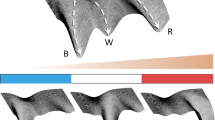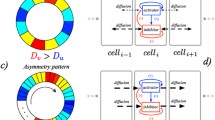Abstract.
We extend previous models for nearest neighbour ligand-receptor binding to include both lateral induction and inhibition of ligand and receptor production, and different geometries (strings of cells and hexagonal arrays, in addition to square arrays). We demonstrate the possibility of lateral inhibition giving patterns with a characteristic length scale of many cell diameters, when receptor production is included. In contrast, lateral induction combined with inhibition of receptor synthesis cannot give rise to a patterning instability under any circumstances. Interesting new dynamics include the analytical prediction and consequent numerical observation of spatiotemporal oscillations, this depends crucially on the production terms and on the relationship between the decay rates of ligand and free receptor. Our approach allows for a detailed comparison with the model for Delta-Notch interactions of Collier et al. [4], and we find that a formal reduction may be made only when the ligand receptor binding kinetics are very slow. Without such very slow receptor kinetics, spatial pattern formation via lateral inhibition in hexagonal cellular arrays requires significant activation of receptor production, a feature that is not apparent from previous analyses.
Similar content being viewed by others
References
Brandt, R.E., Vickery, L.E.: Cooperativity and dimerization of recombinant human estrogen receptor hormone-binding domain. J. Biol. Chem. 272, 4843–4849 (1997)
Clark, A.J.L., Ishii, S., Richert, N., Merlino, G.T., Pastan, I.: Epidermal growth factor regulates the expression of its own receptor. Proc. Nat. Acad. Sci. USA 82, 8374–8378 (1985)
Coffey, R.J., Derynck, R., Wilcox, J.N., Bringman, T.S., Goustin, A.S., Moses, H.L., Pittelkow, M.R.: Production and auto-induction of transforming growth Factor-α in human keratinocytes. Nature 328, 817–820 (1987)
Collier, J.R., Monk, N.A.M., Maini, P.K., Lewis, J.H.: Pattern formation by lateral inhibition with feedback: A mathematical model of delta–notch intercellular signalling. J. Theor. Biol. 183, 429–446 (1996)
de Celis, J.F., Bray, S.: Feedback mechanisms affecting notch activation at the dorsoventral boundary in the Drosophila wing. Development 124, 3241–3251 (1997)
Doedel, E.J., Champneys, A.R., Fairgrieve, T.R., Kuznetsov, Y.A., Sandstede, B., Wang, X.J., AUTO 97: Continuation and bifurcation software for ordinary differential equations, 1997 Available from http://indy.cs.concordia.ca/auto/main.html
Fagotto, F., Gumbiner, B.M.: Cell contact dependent signalling. Dev. Biol. 180, 445–454 (1996)
Fanger, B., Stephens, J.E., Staros, J.V.: High yield trapping of EGF-induced receptor dimers by cross-linking. FASEB 3, 71–75 (1989)
Fretto, L.J., Snape, A.J., Tomlinson, J.E., Seroogy, J.J., Wolf, D.L., LaRochelle, W.J., Giese, N.A.: Mechanism of platelet-derived growth-factor (PDGF)-AA, (PDGF)-AB, and (PDGF)-BB binding to alpha-PDGF and beta -PDGF receptor. J. Biol. Chem. 268, 3625–3631 (1993)
Hirata, H., Yoshiura, S., Ohtsuka, T., Bessho, Y., Harada, T., Yoshikawa, K., Kageyama, R.: Oscillatory expression of the bHLH factor Hes1 regulated by a negative feedback loop. Science 298, 840–843 (2002)
Hughes, A.D., Clunn, G.F., Refson, J., Demoliou-Mason, C.: Platelet-derived growth factor (PDGF): Actions and mechanisms in vascular smooth muscle. Gen. Pharmac. 27, 1079–1089 (1996)
Huppert, S.S., Jacobson, T.L., Muskavitch, M.A.T.: Feedback regulation is central to Delta-Notch signalling required for Drosophila wing vein morphogenesis. Development 124, 3283–3291 (1997)
Jiang, Y., Aerne, B.L., Smithers, L., Haddon, C., Ish-Horowicz, D., Lewis, J., Notch signalling and the synchronization of the somite segmentation clock. Nature 408, 475–479 (2000)
Jouve, C., Palmeirim, I., Henrique, D., Beckers, J., Gossler, A., Ish-Horowicz, D., Pourquié, O.: Notch signalling is required for cyclic expression of the hairy-like gene HES1 in the presomitic mesoderm. Development 127, 1421–1429 (2000)
Kerszberg, M., Wolpert, L.: Mechanisms for positional signalling by morphogen transport: a theoretical study. J. Theor. Biol. 191, 103–114 (1998)
Kimble, J., Simpson, P.: The LIN-12/Notch signalling pathway and its regulation. Ann. Rev. Cell Dev. Biol. 13, 333–361 (1997)
Klueg, K.M., Parody, T.R., Muskavitch, M.A.: Complex proteolytic processing acts on Delta, a transmembrane ligand for Notch, during Drosophila development. Mol. Biol. Cell. 9, 1709–1723 (1998)
Lander, A.D., Nie, Q., Wan, F.W.M.: Do morphogen gradients arise by diffusion. Dev. Cell. 2, 785–796 (2002)
Lemmon, M.A., Pinchasi, D., Zhou, M., lax, I., Schlessinger, J.: Kit receptor dimerization is driven by bivalent binding of stem cell factor. J. Biol. Chem. 272, 6311–6317 (1997)
Lewis, J.: Neurogenic genes and vertebrate neurogenesis. Curr. Op. Neurobiol. 6, 3–10 (1996)
Lewis, J.: Notch signalling and the control of cell fate choices in vertebrates. Semin. Cell Dev. Biol. 9, 583–589 (1998)
Massagué, J., Pandiella, A.: Membrane-anchored growth factors. Annu. Rev. Biochem. 62, 515–541 (1993)
Meinhardt, H.: Models of biological pattern formation. Academic Press, London, 1982
Meir, E., von Dassow, G., Munro, E., Odell, G.M.: Robustness, flexibility and the role of lateral inhibition in the neurogenic network. Curr. Biol. 12, 778–786 (2002)
Monk, N.A.M.: Restricted-range gradients and travelling fronts in a model of juxtacrine cell relay. Bull. Math. Biol. 60, 901–918 (1998)
Murray, J.D.: Mathematical Biology. Springer Verlag, Berlin, 1989
Owen, M.R.: Waves and propagation failure in discrete space models with nonlinear coupling and feedback. Physica D 173, 59–76 (2002)
Owen, M.R., Sherratt, J.A.: Mathematical modelling of juxtacrine cell signalling. Math. Biosci. 152, 125–150 (1998)
Owen, M.R., Sherratt, J.A., Wearing, H.J.: Lateral induction by juxtacrine signalling is a new mechanism for pattern formation. Dev. Biol. 217, 54–61 (2000)
Painter, K.J., Maini, P.K., Othmer, H.G.: Stripe formation in juvenile Pomecanthus explained by a generalized Turing mechanism with chemotaxis. Proc. Nat. Acad. Sci. USA 96, 5549–5554 (1999)
Panin, V.M., Papayannopoulos, V., Wilson, R., Irvine, K.D.: Fringe modulates Notch-ligand interactions. Nature 387, 908–912 (1997)
Plahte, E.: Pattern formation in discrete cell lattices. J. Math. Biol. 43, 411–445 (2001)
Qi, H., Rand, M.D., Wu, X., Sestan, N., Wang, W., Rakic, P., Xu, T., Artavanis-Tsakonas, S.: Processing of the Notch ligand Delta by the metalloprotease Kuzbanian. Science 283, 91–94 (1999)
Reilly, K.M., Melton, D.A.: Short-range signalling by candidate morphogens of the TGF beta family and evidence for a relay mechanism of induction. Cell 86, 743–754 (1996)
Schnell, S., Maini, P.K., Clock and induction model for somitogenesis. Dev. Dyn. 217, 415–420 (2000)
Skeath, J.B., Carroll, S.B.: Regulation of proneural gene expression and cell fate during neuroblast segregation in the drosophila embryo. Development 114, 939–946 (1992)
Spivak-Kroizman, T., Lemmon, M.A., Dikic, I., Ladbury, J.E., Pinchasi, D., Huang, J., Jaye, M., Crumley, G., Schlessinger, G., Lax, I.: Heparin-induced oligomerization of FGF molecules is responsible for FGF receptor dimerization, activation, and cell proliferation. Cell 79, 1015–1024 (1994)
Turing, A.M.: The chemical basis of morphogenesis. Phil. Trans. R. Soc. Lond. B 237, 37–72 (1952)
Waters, C.M., Oberg, K.C., Carpenter, G., and Overholser, K.A.: Rate constants for binding, dissociation, and internalization of EGF: Effect of receptor occupancy and ligand concentration. Biochemistry 29, 3563–3569 (1990)
Wearing, H.J., Owen, M.R., Sherratt, J.A.: Mathematical modelling of juxtacrine patterning. Bull. Math. Biol. 62, 293–320 (2000)
Wearing, H.J., Sherratt, J.A.: Nonlinear analysis of juxtacrine patterns. SIAM J. Appl. Math. 62, 283–309 (2001)
Whitfield, T., Haddon, C., Lewis, J.: Intercellular signals and cell-fate choices in the developing inner ear: origins of global and of fine-grained pattern. Sem. Cell Dev. Biol. 8, 239–247 (1997)
Wolpert, L.: Positional information and the spatial pattern of cellular differentiation. J. Theor. Biol. 25, 1–47 (1969)
Author information
Authors and Affiliations
Corresponding author
Additional information
Send offprint requests to:Markus R. Owen
Rights and permissions
About this article
Cite this article
Webb, S., Owen, M. Oscillations and patterns in spatially discrete models for developmental intercellular signalling. J. Math. Biol. 48, 444–476 (2004). https://doi.org/10.1007/s00285-003-0247-1
Received:
Revised:
Published:
Issue Date:
DOI: https://doi.org/10.1007/s00285-003-0247-1




